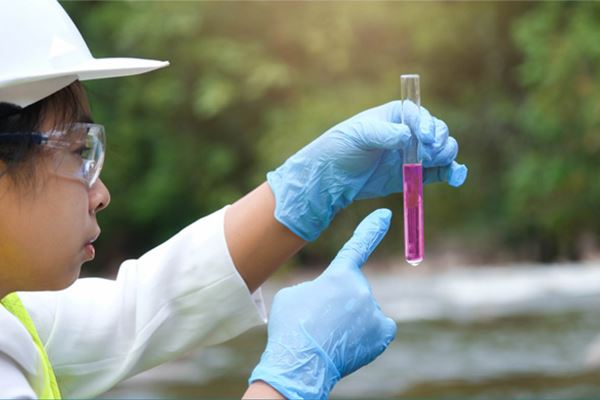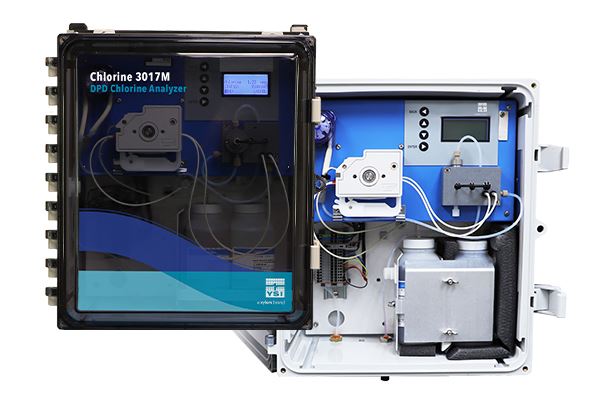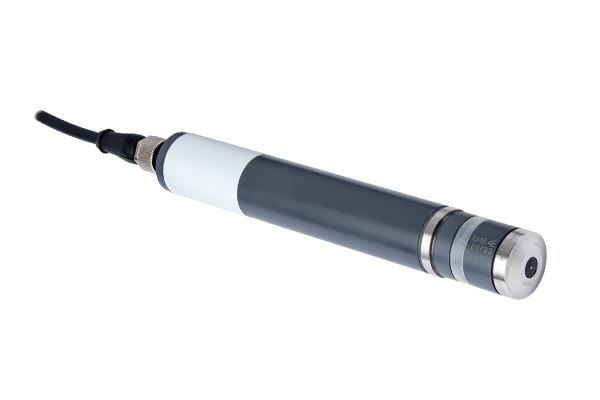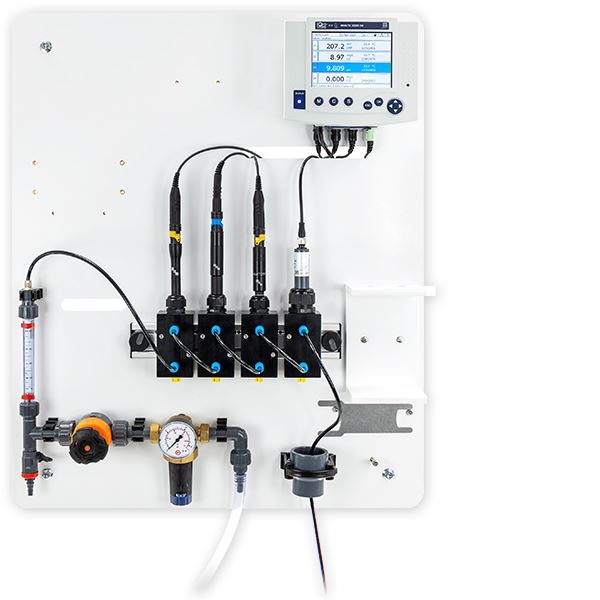Chlorine Measurement Explained: DPD vs. Amperometric
(Updated, September 2025)
Chlorine is one of the most widely used disinfectants in water treatment, providing reliable protection against pathogens in drinking water, wastewater, swimming pools, and industrial applications. Maintaining the correct chlorine residual is critical – too little chlorine risks inadequate disinfection, while too much can create harmful by-products or affect taste and odor.
Two primary technologies used for chlorine determinations are the DPD colorimetric method and amperometric electrode sensors. Both offer accurate results but differ fundamentally in their approach to chlorine determination. This blog post explores each method, highlighting their principles, advantages, limitations, and YSI instrumentation options.
DPD Colorimetric Method
The DPD (N,N-diethyl-p-phenylenediamine) colorimetric method is widely used for chlorine measurement in various applications, including swimming pools, drinking water and wastewater treatment.

DPD colorimetric method
Principle
The DPD method relies on a chemical reaction between chlorine and DPD reagents, which produces a magenta-colored compound. The resulting color intensity is directly proportional to the chlorine concentration and can be quantified either visually or with a spectrophotometer. Both free chlorine and total chlorine can be measured by this method.
- Free chlorine (hypochlorous acid or HOCl and hypochlorite ions or ClO⁻) oxidizes the DPD reagent at a pH value between 6.3 and 6.6 and forms the pink-colored compound. A buffer solution for free chlorine maintains the correct pH value.
- Total chlorine (free chlorine and chloramines) requires the addition of a potassium iodide reagent, which reacts with chloramines to oxidize iodide to iodine, further oxidizing the DPD reagent at a pH of 6.5-8.5. A buffer solution for total chlorine contains potassium iodide and maintains the correct pH value.
The DPD colorimetric method is the compliance standard measurement for free or total chlorine determination under EPA Method 334.0 and Standard Methods 4500-Cl G, as approved by the U.S. EPA for both drinking water (Safe Drinking Water Act) and wastewater (Clean Water Act).1
Procedure
- Collect a water sample in a test cell or cuvette.
- Add DPD reagents to the water sample (powder and buffer).
- Mix the reagents thoroughly to ensure complete reaction.
- Allow the color to develop for a specific duration.
- Compare the resulting color intensity visually with a color scale or measure the absorbance at a specific wavelength with a photometer.
- Determine the chlorine concentration based on the color intensity or absorbance.
Advantages
- Widely recognized compliance method.
- Reliable accuracy across the calibration range.
- Measures both free and total chlorine.
- Not affected by sample pH, temperature, flow or pressure.
- Suitable for both online and laboratory applications.
Limitations
- Requires reagents, which must be replenished regularly.
- Susceptible to interferences from iron, manganese and other oxidizing/reducing agents.

YSI’s 3017M DPD Chlorine Analyzer
Instrumentation
The 3017M DPD Chlorine Analyzer provides continuous free or total chlorine measurements for applications where the DPD colorimetric method is preferred. This analyzer is designed to streamline the chlorine determination process by automating the colorimetric method, offering significant advantages over traditional manual testing.
The 3017M simplifies the procedure by automatically mixing the DPD reagents with the water sample and precisely timing the color development. The analyzer then measures the resulting color intensity or absorbance, providing accurate and reliable chlorine concentration values. This automated approach not only enhances efficiency and repeatability but also reduces the potential for human error.
The analyzer is accurate, reliable, and built with advanced flow injection technology, factory calibration, and simplified tubing, which lower reagent use and maintenance requirements. The 3017M is a robust and dependable solution for DPD colorimetric chlorine measurement in various water treatment and quality control applications. [Learn more; Watch the 3017M Online Chlorine Analyzer Overview video.]
Amperometric Electrode Method
Amperometric electrode-based methods offer an alternative approach for chlorine measurement. These methods utilize a specialized electrode to detect chlorine ions and measure the current produced during the reaction.

YSI's amperometric electrode sensor
Principle
Amperometric sensors measure chlorine electrochemically. Chlorine species contained in water diffuse through a selective membrane and are reduced to chloride ions (Cl-) at the working electrode (cathode), typically made of gold. At the counter electrode (anode), typically made of silver, chloride ions react with silver to form silver chloride, releasing electrons. The oxidation-reduction reactions occurring at the working and counter electrode result in a flow of electrons, which generate an electric current proportional to the chlorine ion concentration. Novel amperometric electrode sensors can measure free or total chlorine, depending on the sensor type selected.
- Free chlorine measures dissolved chlorine gas (Cl2), hypochlorous acid (HOCl), hypochlorite (OCl-), and chlorine bound to cyanuric acid. Traditional free chlorine amperometric sensors only measure HOCl, which require external pH compensation since HOCl and OCl- species formation is dependent on pH.
- Total chlorine measures free chlorine and chloramines. A specialized electrolyte formulation converts chloramines into a measurable species inside the membrane.
While amperometric sensors may involve a higher initial investment and require periodic calibration and maintenance, their ability to provide real-time data, reduce the need for manual intervention, and operate effectively in automated monitoring systems makes them an essential choice for chlorine measurement in water treatment applications.
Procedure
- Immerse the chlorine-selective electrode and the reference electrode in the water sample.
- Apply a small voltage to the electrodes to establish a constant potential.
- Measure the resulting current generated due to the electrochemical reaction between chlorine and the electrode.
- Calibrate the electrode using known chlorine standards to establish a linear relationship between current and chlorine concentration.
- Determine the chlorine concentration based on the measured current.
Advantages
- Continuous, real-time monitoring.
- High sensitivity for low chlorine concentrations.
- Minimal interference from turbidity or color.
- No reagents required.
Limitations
- Higher upfront initial investment compared to DPD analyzers.
- Requires calibration against a reference method (typically DPD).
- Sensitive to changes in sample flow, pH, temperature, and pressure.
- Periodic maintenance required (membrane/electrolyte replacement, calibration checks).
Instrumentation
YSI’s FCML (free chlorine) and TCML (total chlorine) sensors offer high sensitivity, making them particularly well-suited for detecting low chlorine concentrations. Moreover, they exhibit minimal interference from colored substances or turbidity in the water, providing accurate and reliable results even in challenging environmental conditions.
Due to their special design (potentiostatic 3-electrode system), the sensors detect free chlorine (sum of gaseous dissolved chlorine, hypochlorous acid and hypochlorite) as well as chlorine bound to isocyanuric acid. As a result, the sensors are characterized by a greatly reduced pH dependency. The sensors have integrated measurement electronics and provide a temperature-compensated measurement signal. Zero point adjustment is not necessary. Regular calibration is carried out by comparison with the photometric DPD method in accordance with DIN 38408.
For commissioning and maintenance best practices on amperometric sensors, see our guide: How to Implement Smart Chlorine Monitoring.

YSI water monitoring panel
Method Comparison
|
DPD Colorimetric (3017M) |
Amperometric (FCML and TCML) |
| Measurement Technique |
Colorimetric, Reagent-based
|
Electrochemical, Electrode-based
|
|
Description
|
The standard measurement method of chlorine. This technique uses reagents and a photometer to measure the amount of free or total chlorine in a sample. |
Designed for process control using two dissimilar electrodes (anode and cathode) to measure the change in current based on a chemical reaction taking place that is proportional to the amount of chlorine in the sample. |
|
Measurement Range
|
- 0-5 mg/L (free or total chlorine)
- Threshold: 0.03 mg/L
|
- 0.005-20.00 mg/L (free chlorine)
- 0.01-2.00 mg/L (total chlorine)
|
|
Interferences
|
Iron causes negative interference at all levels. Manganese causes positive interference at all levels.
|
Dependent on consistent pH, sample temperature, flow, and pressure, chlorine concentration cannot fluctuate more than +- 20% or be at zero.
|
|
Maintenance
|
- Replace reagents monthly
- Replace tubing every 6-months
- Cleaning of optics requirement dependent on application
|
- New electrolyte every 6 months
- New membrane every 12 months
- Electrode polishing, if required
|
|
Calibration
|
- No calibration required. Factory calibrated
- 1-point calibration based on a grab sample possible
|
- Weekly reference measurement recommended
- Membrane conditioning and sensor calibration required every 1-2 months and after a membrane change
|
|
Causes of Fouling
|
Air in sample line, biological growth in measurement cell and sample turbidity >100 NTU.
|
Iron, manganese and high turbidity can increase calibration and maintenance requirements.
|
|
NSF-61 Certified?
|
No, side stream analyzer.
|
No, side stream analyzer.
|
Conclusion
Both DPD colorimetric and amperometric electrode methods possess unique advantages and disadvantages in chlorine measurement. The 3017M is ideal for compliance reporting and regulatory monitoring where reagent-based methods are required. The FCML and TCML sensors deliver reagent-free, continuous monitoring with reduced pH dependency and high sensitivity, making them well-suited for process control. The choice between these two methods depends on the specific application, required accuracy, and budget considerations. Ultimately, both methods contribute to maintaining chlorine levels within the desired range for safe and efficient water treatment processes.
References:
- United States Environmental Protection Agency. Stage 1 and Stage 2 Disinfectants and Disinfection Byproducts Rules: Methods Table. Office of Water, Washington, DC, 2024.
- Standard Methods for the Examination of Water and Wastewater. 4500-Cl G: DPD Colorimetric Method. American Public Health Association, American Water Works Association, Water Environment Federation.
DPD vs. Amperometric: Understanding Chlorine Sensor Technologies
On-Demand Webinar | 1 Hour
